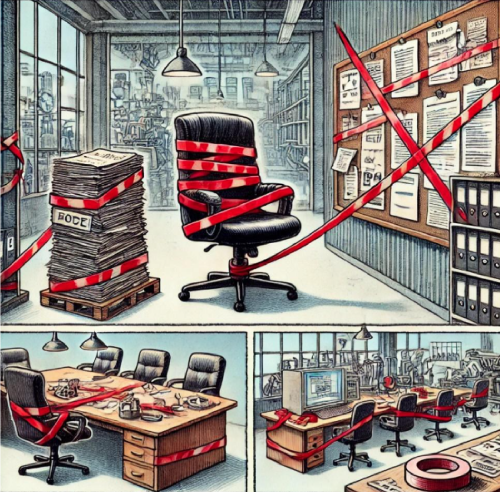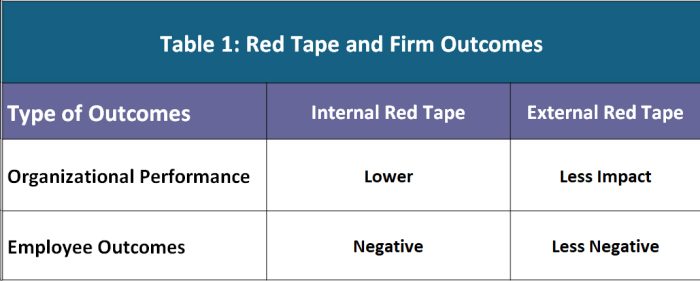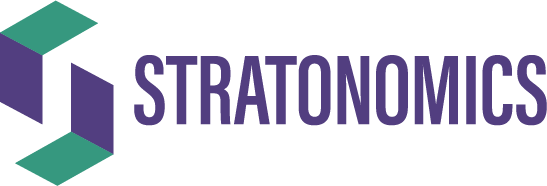A 2021 research paper examined the potential cost of two types of red tape on organizational performance and employee outcomes.
Internal Red Tape: Internal red tape refers to “rules and procedures imposed by the organization itself that are perceived as burdensome and unnecessary.”
External Red Tape: External red tape refers to “regulations and procedures imposed by external entities, such as government agencies, that organizations must comply with.”

Study Methodology
The study is a meta-analysis, a statistical summary, of 25 empirical studies that collectively encompass 83 effect sizes and a total sample size of 17,191 data points. The 25 studies span various sectors and administrative traditions.
Results
Red tape has a small-to-medium negative association with both organizational performance and employee outcomes. The study highlights that internal red tape—rules and procedures imposed by the organization itself—is more harmful than external red tape (See Table 1).

Impact on Organizational Performance
Red tape negatively affects organizational performance by creating inefficiencies and hindering them from “being responsive to clients.” The inefficiency and lack of customer responsiveness is higher when the red tape is self-imposed because it spawns cumbersome procedures.
Impact on Employee Outcomes
Red tape saps employee morale and satisfaction as employees feel powerless and disengaged. The study notes, “Bureaucratic controls have as much potential to alienate workers as any assembly-line process.”
Why Increased Red Tape and Bureaucracy Hurts
- Reduced Autonomy: Bureaucratic red tape becomes a “significant constraint on employees’ ability to exercise discretion, which undermines their sense of autonomy and job satisfaction,” according to the authors.
- Increased Frustration: Employees become frustrated with unnecessary procedures because “employees have to navigate through unnecessary bureaucratic hurdles, impacting their ability to perform and their overall satisfaction,” state the authors.
- Lower Motivation: Excessive rules and regulations can demotivate employees who feel “bogged down by excessive regulations…leading to decreased engagement and productivity,” according to the authors.
- Reduced Speed and Increased Inefficiency: Internal red tape invariably gums up speed and efficiency. “Inefficiencies caused by red tape can significantly slow down organizational processes and decision-making, ultimately affecting performance,” state the authors.
Strategic Implications
For any CEO, reducing process (bureaucracy) and form-filling (red tape) is critical to succeed. Here are some strategies to consider:
- Simplify Procedures: Streamline and simplify procedures to reduce the time and effort employees spend on bureaucratic tasks. Typically, more than 70% of an employee’s time should be spent working on their daily work, i.e., core responsibilities.
- Empower Employees: Give employees more authority, autonomy and flexibility to make decisions, act, and not worry about small mistakes. Action moves things forward and boosts morale and productivity.
- Focus on Action not Motion: Shift the focus from rigid adherence to procedures and creation of elaborate plans to action. Enable them to act, even if not 100% correct.
- Regular Reviews: Conduct regular reviews of internal rules and regulations to identify and eliminate redundant or outdated procedures. If you eliminate one process or one form every month, you can greatly improve your company.
Conclusion
Bureaucracy and red tape hinder organizational success and hurt employees. By taking proactive steps to minimize them your organization can experience better performance and employee satisfaction.
References:
- George, Bert, Sanjay K. Pandey, Bram Steijn, Adelien Decramer, and Mieke Audenaert (2021), “Red Tape, Organizational Performance, and Employee Outcomes: Meta-analysis, Meta-regression, and Research Agenda,” Public Administration Review, July-August. DOI: 10.1111/puar.13327.
